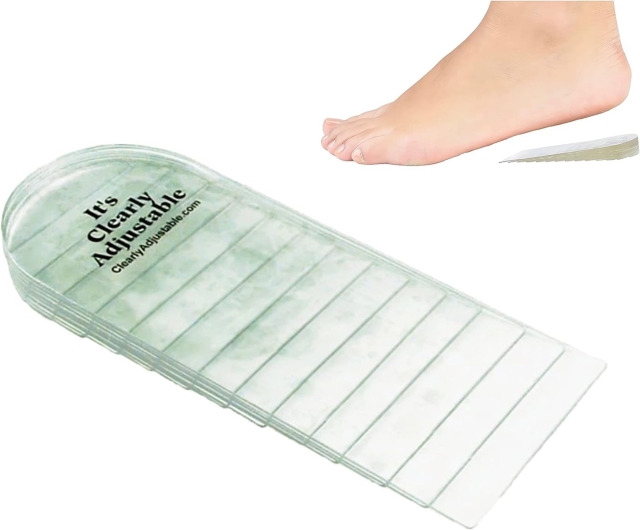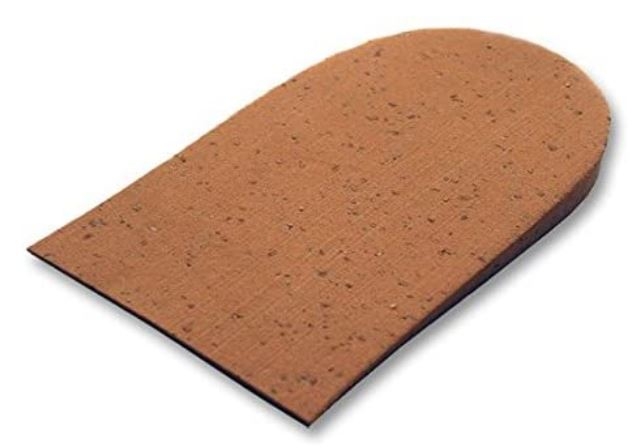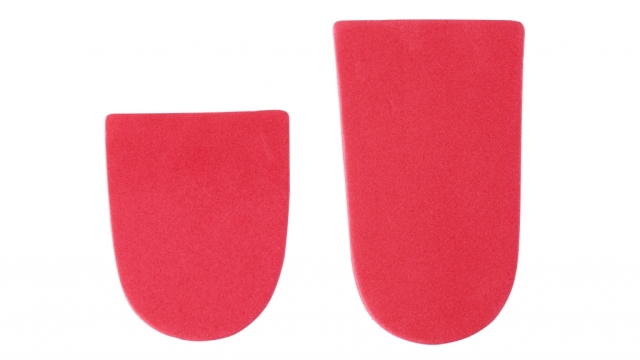Heel Lifts - Buyers Guide

Orthotic heel lifts or shoe lifts are required by a surprisingly large percentage of people at some time in our lives, for reasons ranging from runners gait correction or golf swing improvement, to Achilles' tendonitis or other conditions such as lower back pain, or for physical therapy and post-stroke or post-surgical rehabilitation needs.
This article is intended to give an overview of the different types of in-shoe orthotic heel inserts available and their strengths and shortcomings, and to assist you in choosing appropriate heel lift products for use in compensating for leg length discrepancy or short leg syndrome, treating Achilles tendonitis, for sports, or for prosthetic and rehab uses.
Background
In recent times past, most shoes were made by gluing, sewing, and nailing pieces of leather and rubber, and any changes to customize a shoe were generally performed by a shoemaker.
As shoe technology has changed, it has become common to mold a complex synthetic sole along with the upper portion of the shoe as part of a single manufacturing process. As a consequence, it has become much more difficult to modify shoes externally without impairing their appearance.
At the same time, molded-sole shoes usually have a user-replaceable molded insole or footbed, so it has become easier and more common for the wearer to change the fit or feel of the shoe internally, using over-the-counter or custom-made orthotic inserts. Further, our body of knowledge about body mechanics has improved greatly in recent years, and so the types of changes prescribed by medical professionals have become much more sophisticated.
New technology is needed to keep pace with these changes in manufacturing and medical practice, and heel inserts have evolved in response.
Two different types of heel inserts are used for a variety of medical conditions, including leg length discrepancy, lower back pain, Achilles tendon problems, heel spurs, arthritic inflammation, and gait correction. Some of these conditions require very different types of inserts to alleviate pain or inflammation in a wide variety of joints, muscles, and connective tissue.
Heel lifts and heel cushions are not the same thing.
Firm heel lifts or shoe lifts are used as therapy or support for various reasons:
- Leg Length Discrepancy
- Postural imbalance
- Lower back pain or spinal scoliosis
- Achilles tendon condition
- Rehabilitation needs
- Prosthetic adjustment
- Sports uses such as gait or golf swing correction or compensation for tilted running surfaces
Soft heel pads or heel cushions, are used for other conditions, such as:
Impact-generated conditions. The repeated impacts of walking or running can cause pain in various joints and muscles in the lower body and back, particularly if inflammation is already present.
Pressure-related problems, such as Plantar warts or heel spurs, where pressure on a small area of the heel is painful.
This document does not address soft heel cushions or heel pads; it is intended to give guidance only in selecting heel lifts, which are firm heel inserts used for conditions where elevation of one or both heels is required for various biomechanical reasons.
Heel Lift Selection Issues
It is likely that you may want several different types of heel lifts for different shoes. No single heel lift works perfectly for every daily need, but therapeutic aspects of using heel lifts are most effective if they are used in all of your shoes, so that you are supported by the lift as much of the time as possible.
Consider whether your need for heel elevation is temporary or long-term. Temporary use may require varying elevation over time. Long-term use puts a premium on foot comfort and minimal disturbance of shoe fit. Sports uses of heel lifts will almost always require firm support to retain control and prevent injuries.
The amount of elevation you need can affect your choice of a heel lift or external shoe heel or sole additions. It is generally accepted that it is unwise and uncomfortable to add more than 12mm (1/2") of heel elevation inside a shoe using inserts, and many people are uncomfortable with that much in the shoe.
The maximum amount of elevation that will be comfortable in a shoe will depend on the individual and the style and size of the shoe, with smaller feet generally able to accommodate less height, and lace-up shoes allowing more than slip-ons or loafers. The maximum height you can comfortably use in a shoe will also be determined by the tightness of the shoe fit, and the amount of heel elevation already created by the heel of the shoes. Laced shoes with four or five eyelets can assist in accommodating a heel lift.
The type of shoes in which you use heel lifts may determine the type of lift you can use with them. In general, closed-heel shoes are easiest to adapt with a heel lift, while sandals or flip-flops may require an unobtrusive transparent heel lift for best appearance, or methods which a shoe-repair shop can provide, such as a wedge built into the sole.
More than 12mm of elevation should be done at least partially with external modifications to the shoe, and should include adding elevation under the entire foot, rather than just the heel, for stability and minimal disturbance of lower-body balance.
Cosmetic heel lifts sold to increase height by more than 1/2" are simply unusable, as your heel will not stay in the shoe when walking. If you intend to buy shoes to add to your apparent height, shoes specifically made for the purpose will be far more comfortable and less potentially damaging to your feet and legs.
Using heel lifts for height increase during active sports is very risky and is likely to result in falls and sprained ankles due to the loss of stability they cause, and may cause Achilles' tendon problems as well.
Design Considerations for Shoe Lifts
There are several things to look for when choosing heel lifts:
Well-designed heel lifts should be long enough to extend well forward under the arch, toward the ball of the foot; this avoids "bridging" between the heel and the ball of the foot.
If the lift is too short along the length of the foot, you can cause foot problems, and will be able to feel the heel lift underfoot. A "slope" that is too steep also causes the foot to slip forward in the shoe when walking, and does not support the foot well. The longer the heel lift, the better.
A well-designed in-shoe lift should have a long constant slope from the back all the way to the front edge. A heel lift should not be tapered only at the front and level at the back.
If there is any change in the taper, you will be able to feel the transition as a "hump" in the lift, which is both uncomfortable and potentially damaging to the foot. The hump will also tend to push the lift forward in the shoe when walking, and this makes it difficult to fix such a lift in place.
An ideal in-shoe heel lift should add elevation but not compressibility, to avoid creating vertical heel motion and rubbing in the shoe. Up-and-down rubbing of this type can cause Achilles tendon irritation, as well as calluses and blisters.
Firm shoe lifts are mandatory for active sports, to avoid loss of control through the motion in the shoe, and potential injuries, most often ankle sprains.
It may be necessary for a lift to perform multiple functions, e.g. varus/valgus wedging at the same time as it provides elevation for leg length discrepancy or Achilles tendon problems. An ideal heel lift should be customizable to correct for all conditions without placing several different products in your shoes.
In-shoe lifts must remain in place under the heel. It is very annoying to feel a heel lift crawling forward underfoot. If shoe lifts made of compressible material are to be placed under the footbed or insole, you may wish to have a shoe-repair shop insert and attach them.
You should determine the exact heel lift height that makes you most comfortable by experimenting with different heights. It may be that the difference between 8mm and 9mm is just the difference that will make you best balanced and most comfortable. Adjust a lift with pieces of cardboard under it to determine what works best for you, or use an adjustable heel lift to determine the ideal height. You may find that there is a tradeoff between shoe fit and height, so experiment until you find just the right height, and then use that whenever possible.
If some of your shoes are simply too tight with the desired elevation from a heel lift, using 1mm less at times may make the shoes wearable without causing harm. You may wish to take a shoe lift with you when shopping for shoes, to check for fit with the lift in place.
For consistency, heel lift height should be measured at the point where the calcaneal bone rests upon it, not at the back end of the lift. This effective height can be measured at the point where the curve at the back of the lift joins the straight sides.
Heel Lift Materials
With all that in mind, let us consider the various types and materials of commonly available heel-elevating shoe lifts.
Cork Heel Lifts
Cork is an attractive material for certain types of in-shoe lifts, as it is inexpensive and lightweight, and does not crush much. Cork lifts are available in a wide range of sizes and heights, and typically are covered with a leather or vinyl surface to protect the cork against abrasion and increase their life.
Cork lifts are a particularly good alternative for ladies dress shoes, due to their light weight.
Cork heel lifts can be placed above or under the insole or heel pad of the shoe. Placing a firm lift under the insole means that your foot rests on the same amount of cushioning as in the unmodified shoe - the lift simply adds height, rather than bounce. This is particularly important for leg length compensation, where a lift is used in only one shoe - with a firm lift placed under the insole, both shoes will feel alike.
Cork shoe lifts are a good choice if the user does not wish to lift the insole of a shoe in order to place the lift beneath the insole, because the slight resiliency of cork tends to be more comfortable directly underfoot than harder materials.
Cork lifts are available in several widths and several heights, and are easily fit to nearly any shoe, since the material is easily cut with a knife. Cork adheres well with contact adhesives or double-faced tape to fix the lift permanently in place.
The primary shortcoming of cork heel lifts is that while they are economical, they are not particularly durable.
Solid Plastic Heel Lifts
Cast or molded plastic shoe lifts are often used for leg-length compensation, and they are more durable than cork or foam rubber for extended heavy use, such as in men's work shoes. These lifts are available in a variety of sizes and heights, and in various firmness of plastic. The ideal firmness, or durometer, is 50-60, since softer plastic will result in long-term loss of height and cause heel rubbing in the shoe.
Solid plastic lifts are designed to be placed beneath the insole or heel pad of a shoe. Placement under the footbed means that the foot rests on the same amount of cushioning as in the unmodified shoe - the lift simply adds height, rather than compressibility.
There is a range of quality in solid plastic lifts: better quality plastic lifts are generally injection-molded rather than cast, as injection molding produces more consistent thickness and better control of the shape. Cast or poured plastic lifts can vary in thickness.
Solid plastic lifts are typically available in several different widths and heights, (commonly 3mm, 5mm, 7mm, 9mm, & 12mm). Special double-faced tape is used to fix these lifts in place, rather than glue.
If solid plastic lifts have a flaw, it is that they do not fit perfectly in all shoes due to the relative rigidity of the plastic; the shape of the inner sole of shoes varies greatly - some are curved, some flat, some narrow, some wide; a firm plastic lift is more difficult to adapt to different shoes than less rigid materials such as cork.
Foam Rubber, EVA, or Urethane Foam Heel Lifts
Foam rubber in-shoe lifts are widely available in shoe-repair shops, and are usually supplied with a leather or fabric top surface. These lifts can be placed directly under the foot or under an insole, and typically provide a useful maximum of no more than 9mm (3/8") of height.
Foam rubber heel lifts are sometimes used for leg-length compensation, but spongy rubber material has certain problems:
- Foam lifts will crush permanently with use. When the foam crushes, it loses its original height, so it is not well suited to long-term use.
- Foam urethane or rubber materials allow the heel to move up and down in the shoe as much as half the thickness of the lift. S
Adjustable Heel Lifts
Adjustable heel lifts allow you to change the height of the lift by removing and replacing layers of flexible material.
Adjustable shoe lifts offer advantages both to medical professionals and to the user:
Adjustable lifts are particularly useful when you are making a transition from no lift to or from a prescribed height - the elevation of the lift can be changed gradually to allow you to become accustomed to the change with less stress.
Adjustable heel lifts permit you to make small changes to determine exactly what height is most comfortable, and the elevation can also be changed in small amounts to ease fit in tight shoes.
Adjustable lifts are useful for therapeutic professionals - fewer sizes are required to fit everyone's needs, so inventory and stocking costs are lower.
Adjustable heel lifts are available in two varieties: those composed of three layers of rubber or soft plastic foam, and the multi-layered Clearly Adjustable lift, which is made of many thin layers of vinyl.
Three-layer lifts are widely sold as "adjust-a-lift," "adjust-a-heel," or similar names. All are made of three layers of 3mm foam rubber, cork, or soft plastic with a leather or fabric cover on the top; the layers can be removed or replaced to choose a height in 3mm increments. These lifts are intended for use directly underfoot, rather than beneath the insole.
These three-layer lifts have a significant disadvantage: if one or two of the foam layers are removed, it creates a flat top on the lift, rather than the ideal continuous taper. The edge between the flat top and the tapered portion will be felt as a lump underfoot, and tends to make the lift crawl forward in the shoe.
If foam rubber adjustable lifts are used for heel elevation, a leather top surface is more desirable than stretch fabric, as leather is stiff enough to reduce the cushioning of the underlying foam rubber, and this helps reduce the added vertical heel motion in the shoe.
Because of the top covering, three-layer lifts are most useful when the lift must be placed directly under the foot; on top of the heel pad or insole. This also makes them applicable for sandals and shoes where the insole cannot easily be lifted.
The newest type of adjustable lift, the Clearly Adjustable heel lift, is designed to be used under the insole or footbed, and is not compressible, so both shoes feel alike, and no additional cushioning or heel rubbing is introduced in the shoe. The fourteen 1mm layers of firm plastic material allow the lift to mold itself to the shape of the shoe, and this helps in making it more comfortable than solid plastic lifts.
The use of many layers in the Clearly Adjustable heel lift provides peel-and-replace adjustment of the lift height to 1mm for best foot comfort, and the soft plastic material permits trimming and customization with scissors.
Content from GW Heel Lifts (USA).





